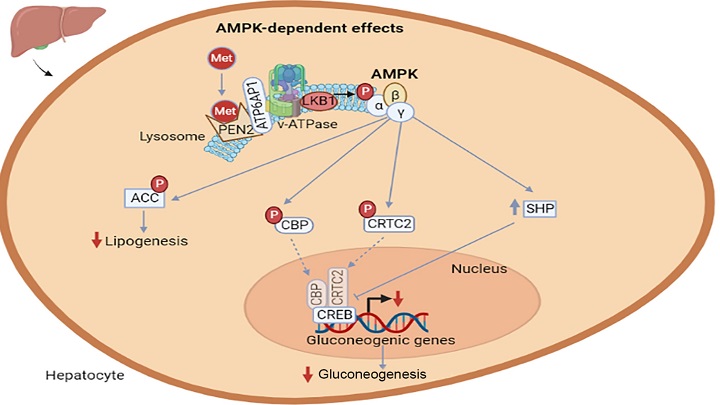Discovering the action mechanism of the most widely used drug to fight type 2 diabetes

There are still many enigmas about the mechanism of action of metformin, the most prescribed drug to treat diabetes mellitus, also known as type 2 diabetes. Now, a review article published in the journal Trends in Pharmacological Sciences highlights how metformin is able to interact with the liver and gut to reduce circulating glucose levels.
The study is led by Professor Manuel Vázquez-Carrera, from the Faculty of Pharmacy and Food Sciences of the University of Barcelona, the Institute of Biomedicine of the UB (IBUB) and the Sant Joan de Déu Research Institute (IRSJD), and the Diabetes and Associated Metabolic Diseases Networking Biomedical Research Centre (CIBERDEM).

There are still many enigmas about the mechanism of action of metformin, the most prescribed drug to treat diabetes mellitus, also known as type 2 diabetes. Now, a review article published in the journal Trends in Pharmacological Sciences highlights how metformin is able to interact with the liver and gut to reduce circulating glucose levels.
The study is led by Professor Manuel Vázquez-Carrera, from the Faculty of Pharmacy and Food Sciences of the University of Barcelona, the Institute of Biomedicine of the UB (IBUB) and the Sant Joan de Déu Research Institute (IRSJD), and the Diabetes and Associated Metabolic Diseases Networking Biomedical Research Centre (CIBERDEM).
Metformin: how to reduce glucose production?
Type 2 diabetes is a metabolic disease in which there is an excessive amount of glucose in the blood, due to the body's inability to respond adequately to the actions of insulin — a process known as insulin resistance — or to produce this hormone. To fight this disease, professionals usually use metformin, an orally administered drug that reduces the contribution of glucose in the blood (hypoglycemic) and improves its peripheral circulation.
"Historically, it has been thought that the main place of action of metformin is the liver, but the most recent findings confirm that it also has notable effects on the gut", comments Professor Manuel Vázquez-Carrera, head of the Pharmacological Targets in Inflammation and Metabolic Diseases Research Group of the UB. "That is why —he adds— most of the most advanced studies focus on the two organs where metformin's actions appear to be most important: the liver and the gut" he notes.
The paper highlights how a team has recently described that, in the liver, metformin is able to increase the levels of miRNA let-7, a signalling molecule in several physiological functions (PNAS, 2022). This pathway reduces hepatic glucose production, which is the process that contributes most to the glucose increase in patients with type 2 diabetes.
"These results open up the possibility of activating the expression of the miRNA let-7, which is reduced in diabetic states, as a new strategy for the treatment of diabetes mellitus", says Vázquez-Carrera.
Parallelly, the effects of metformin on the intestine have also been described. In one of the most recent studies, another team has shown that metformin activates the conversion of glucose to lactate and acetate in the intestine (PNAS, 2023). "These two metabolites reach the liver via the portal vein and trigger processes that reduce hepatic glucose production. Thus, metformin establishes a crosstalk between the intestine and the liver that contributes to its antidiabetic effects", the researcher notes.
It should be recalled that the team led by Manuel Vázquez-Carrera also determined that metformin requires the presence of growth differentiation factor 15 (GDF15) to activate its main pharmacological target (AMPK) and have antidiabetic effects (Pharmacological Research, 2022).
"In short, all of the new studies reviewed in this new article help resolve outstanding enigmas and provide data to understand how metformin reduces hepatic glucose production, which is the main antidiabetic effect of this drug."
Reference article:
Barroso, E.; Montori-Grau, M.; Wahli, W.; Palomer, X.; Vázquez-Carrera, M. “Striking a gut–liver balance for the antidiabetic effects of metformin”. Trends in Pharmacological Sciences, May 2023. Doi: /10.1016/j.tips.2023.04.004
Multimedia gallery

Professor Manuel Vázquez-Carrera, from the Faculty of Pharmacy and Food Sciences and the Institute of Biomedicine of the UB (IBUB).

